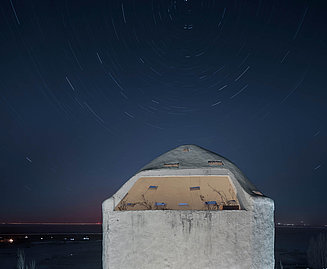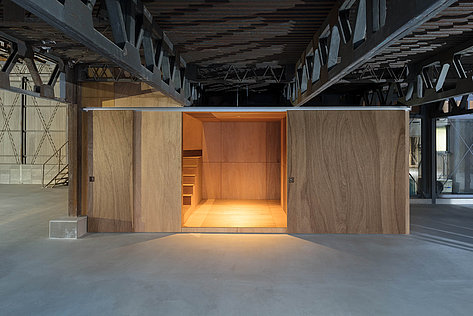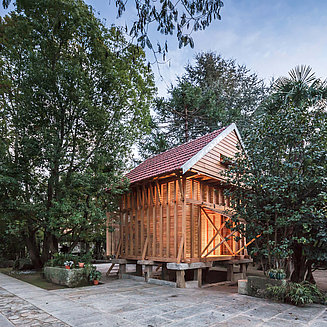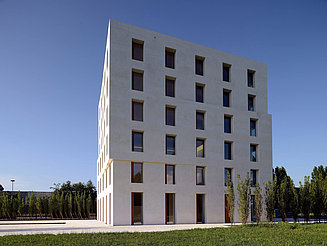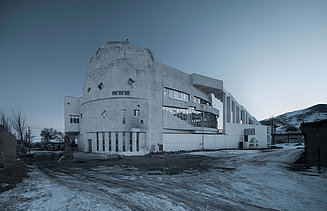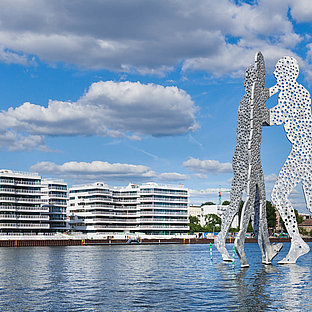(MY) FREE SPACE – Peter Reischer
12 min readThe urge generated by the masses of high-gloss photos published in magazines to write a hymn of praise about free space or freedom in architecture and the innumerable possibilities (seemingly) available to us today would be tempting indeed, and perhaps even justified. Pictures of palaces made of steel, wood, concrete and other materials, of skyscrapers and parametric marvels are plentiful. Impressive open space designs can also be found among the works of many a creative architect.
However, to write a eulogy about the general achievements of our civilisation, about the free space gained by them for human beings and about the state of democracy would be out of place in view of the current global situation. According to an FAO study, the World Food Report states that the global agriculture could feed twice the world’s population without any problems. Why then does one child below the age of ten die of starvation every five seconds in this world? That makes 17,000 people every day. Jean Ziegler has expressed this very clearly and drastically: “A child dying of starvation is murdered!” This statement was one of the reasons why he was not allowed to hold his speech at the opening ceremony of the Salzburg Festival in 2011. Too many people in the audience would have felt personally accused, and no one sitting in an opera house wants to feel like being called a murderer on hearing this statement.
Quite apart from this, it would be easy to paint an apocalyptic or dystopic future and write about it in the form of a forecast. An area of nature equal to several thousand airfields or (pardon) football fields is being covered with concrete every day. The pieces of architecture built on these areas are not even opened on time and become obsolete in the course of time. Landmarks are created and disappear, people starve beside pots full of food, the homeless are begging in front of luxury shop windows for the super-rich, searching for the meaning of life no longer makes sense, Westerners seek their salvation in the Eastern concept of reincarnation, while those in the East desperately try to escape the cycle of rebirth. Are the roles and positions perhaps being reversed here?
Now I come to my own free space. In spite of all those negative forecasts from scientists and futurologists, and although I realise how serious the situation really is, I don’t want to write a gloomy article. Too great is my faith in what is good in human beings, in their evolutionary qualities and in the victory of sanity over reptile brains. Everything that has been said by people like Ziegler or Ugo Bardi (Bardi is a long-standing member of the Club of Rome, his book “The Seneca Effect“ deals with the collapse of global systems. Here it is the famous or notorious last straw which suddenly breaks the camel’s back, regardless of whether the issue is interpersonal relations, political systems or ecological problems such as the climate change), all of this need not necessarily be seen as a threat to our self-image, but can be taken as a challenge instead.
A wake-up call, to see the world as a reality rather than as a product of economic growth. One football field less under concrete is not a step back, but a real step forward. I hope for and count on this type of sanity, although I find this sometimes very difficult in view of certain election results (in USA, Austria, Germany and the Czech Republic). But this also must be accepted, since it falls into the category of “free-will decisions” on the part of the voters and is an integral part of democratic freedom. No one can take away our responsibility for how we use this freedom.
If we consider the development of mankind as a line spiralling upwards, as do, for example, some French philosophers, we will see that this spiral turns into a straight line at a certain point and then threatens to disappear into nothingness. When we have lost our way on a walking tour, when we have taken a wrong turn, the vital point is to turn around and retrace our steps. Taking such a wrong turn can be compared with a crisis, and crises happen in human history at periodic intervals.
And in the middle of a crisis, we lose sight of our purpose and goals. But in such cases, turning back or returning to traditional values invariably means going right back to the point where we left the right path. To me, finding that point seems to be the big problem today. There are many schools of thought centring around notions of “back”, “again” or “re-“. Such trends can also be found in architecture. Fewer and fewer architectural teams concentrate on new buildings; instead, they invest a lot of expert knowledge in alternative uses and in remodelling old structures. Construction in existing context is an absolute trend.
The great words, -isms and complex sentences in architectural theory right up to the post-modern era and beyond are stale and worn out. My suggestion
is to disregard the well-known theorists such as Charles Jencks, Robert Venturi, Heinrich Klotz etc., and turn to the intellectual approach of Sir Karl Popper. In his way of thinking, to disregard does not mean to ignore, but to take a critical approach. For Popper takes the basic fallibility of knowledge and science into account. In contrast to a “closed society” (as proposed by Plato, Hegel and Marx, whom he accused of totalitarian traits), he proposed an “open society” not planned on the drawing board, but one which should develop in a pluralistic and evolutionary way by a continuous process of attempts of improvement and corrections of errors. In architectural terms, I see this as something alive and moving, which serves mankind. And this can already be seen more and often in the planning concepts of some architects.
Many planners have a vague, uncomfortable feeling that, in spite of all powerful imagery and perfectionism, there is something wrong with the immense amount of building activity. Tilting and bending things, painting them green – solutions of this kind often cause astonishment, but never focus on human needs. When architecture has developed away from its original purpose of housing and protecting people, from the spiral to the straight line, this could be diagnosed as suffering from a kind of borderline syndrome. Desperately running after continuous progress and maximisation of images, it knows very well that it is on a wrong track. But it is subject to an inner conflict, and this state of tension leads to more and more excesses. Or is it the awareness of the transience of what it intends to build for a small eternity? Why are ideas such as God, faith, hope, love and poetry actually stigmatized and regarded as taboos in architecture?
Here, of course, I would also like to briefly mention the upcoming Architecture Biennale in Venice. Can a clear line be drawn in the choice of themes for the Biennale over recent years with “Common Ground”, “Reporting from the Front“ and now with “Freespace”? From the Show of Egomaniacs (2014) via the Underground (2016) to Women’s Power (2018)? I sincerely hope to avoid any misunderstanding of this concept and especially any deliberate misinterpretation (Honi soit qui mal y pense!). I respect the two architects Yvonne Farrell and Shelley McNamara as very conscientious and responsible people. It is probably no accident that both this year’s curators are primarily known by their buildings for schools and educational institutions. After all, education and learning provide the opportunity of having fewer football fields covered with concrete worldwide in future. And women certainly make a major contribution to the education and development of men’s world.
In 2016, Alejandro Aravena taught us that architecture is one of the civil society’s instruments for organising the space in which people live and work. This time, Farrell and McNamara will focus on and specify the perspectives for the quality of public and private space of urban areas, territories and countryside areas as the main purpose of architecture. Some passages from their press releases are noteworthy. For instance, they speak of a “democratic space, unprogrammed and free for unplanned uses”. This comes close to the “hodological space” (Greek: hodos = way, path) concept of Otto Friedrich Bollnow. He describes a kind of space which exists independently of geometric and Euclidean space, which can be experienced exclusively by human beings through movement. A “living geometry” of this “hodological” connection is totally different from the ideas proposed by architects.
Another good example for the ABSENCE of functional predetermination on the part of the architects or the architecture is the restoration and alternative use of an ancient granary combined with a pigeonry in Portugal by Tiago do Vale Arq.tos. The small, rebuilt wooden structure, which gives viewers a certain poetic feeling, will remain at the disposal of time and nature and be dedicated to all kinds of possible, unpredictable uses.
Some similar approaches can even be found in high-tech Japan. There, Schemata Architects have built a residential unit for a private user inside an old warehouse hall. Since the hall was far too large, a sizeable amount of empty space was left over apart from the space actually used; no one can foresee the exact purpose to which that space will eventually be dedicated, and its future use is will remain undecided. Living next to this empty space is a source of tension; it is in contrast to Western thought in terms of maximization and full utilization of all resources. Here, we have a free space, a space of opportunities, a gift to the user.
For our countries, I would desire, for example, some legislation obliging property owners to plant a tree for every 10 square metres of ground covered with concrete, or to cover 10 square metres of façade with greenery. A (tax-) grant to reward intelligent wastefulness instead of foolish thrift. A change of thought in architecture, away from mere utility and profitability towards a focus on human needs in the use of space. There are plenty of free spaces, since all spaces currently not in use are such free spaces.
And they are already there, all those positive social, economic, ecological and architectural alternatives: public welfare economy, fair banking, car, desk and room sharing, architects engaged in restoration rather than new construction, six-storey high-rise office buildings, which function without heating and cooling (2226 by Arch. Eberle), urban gardening and urban mining, the “new wilderness” in open space design (Berlin/Tempelhof and Vienna/Northern railway station), civil society initiatives and the increasing use of wood in architecture are all examples of change and transformation. Baruch Spinoza’s concept of “meeting God in nature” becomes more and more often visible in the works of some architects. His rationalistic renunciation technique may have model character.
For simplification is a gain, not a loss.
Text: Peter Reischer, journalist and architecture critic
